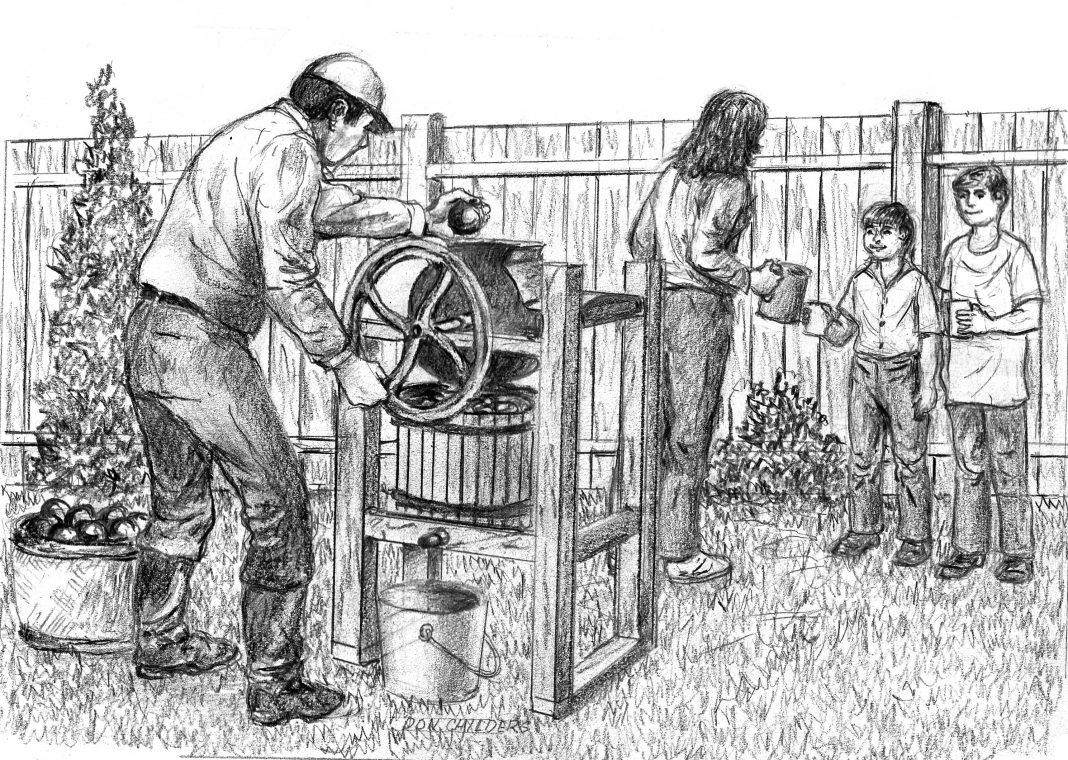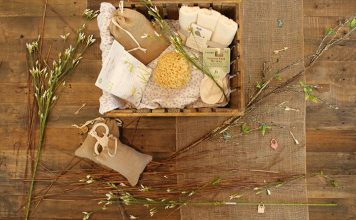By Robert Van Putten
Apples are an important food resource for us. Every year we store hundreds of pounds in our root cellar where they will keep for up to six months. To preserve them, we home can apple butter and applesauce as well as dehydrate apple rings.
Recently we added yet another apple product to our repertoire: apple cider. As one of our friends said, “it’s better than the finest wine.”
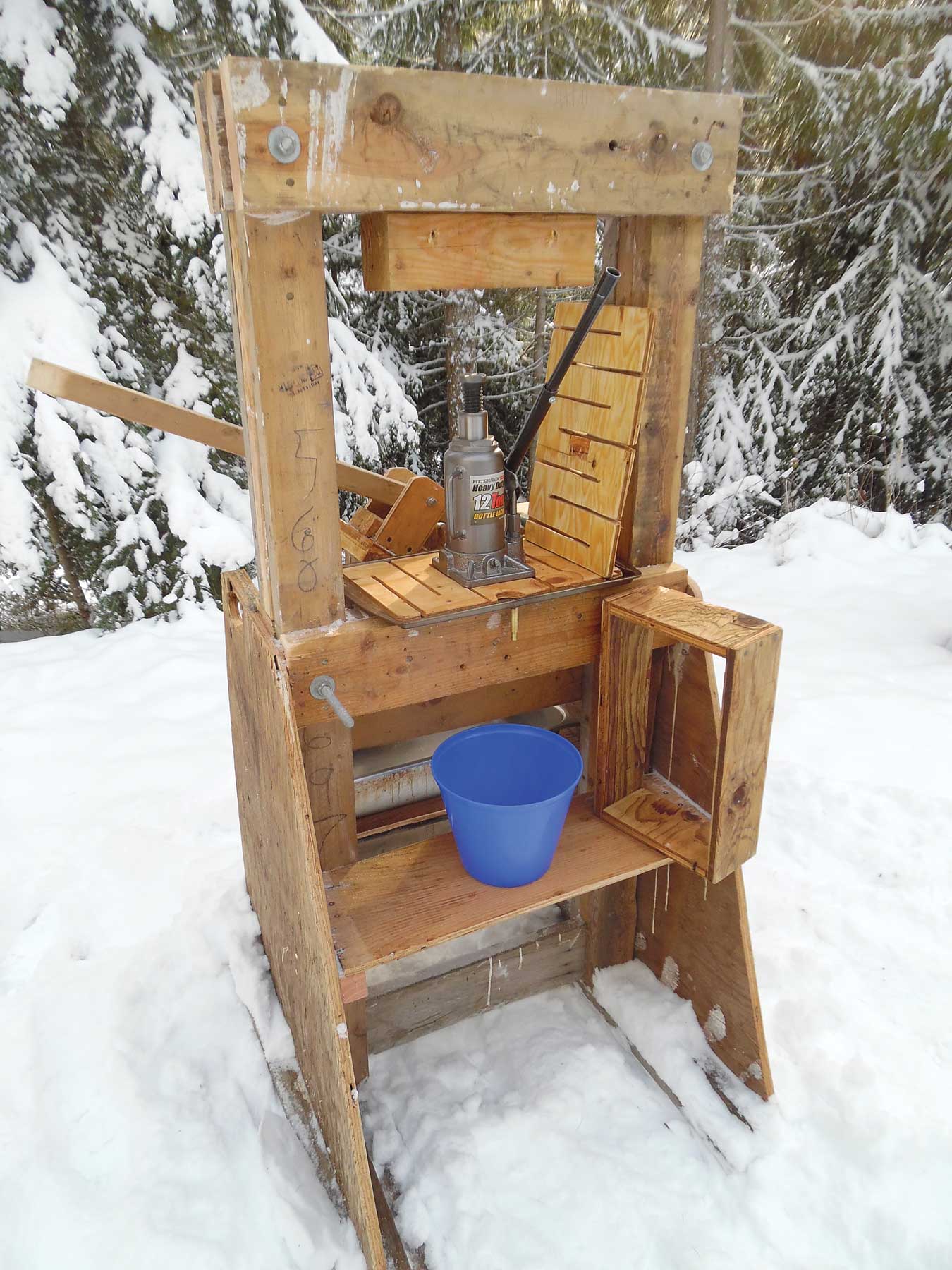
The process
Making cider at home is a simple two-part process. First, mash the apples. Then, squeeze the juice out of the mash. Mashing the apples breaks the cell walls and releases much more juice than pressing sliced apples. In the Middle Ages, large vertical stone wheels were set up to mash apples for cider. In Colonial America, heavy wooden paddles and troughs were used. These days some types of food processors are said to do a good job of it, and one popular way is to buy a new stainless steel garbage disposal grinder and use it just for apples. But because I live-off grid, I needed a non-electric method of mashing apples. I came up with a unique hand-cranked grinder.
Making the apple grinder
This efficient grinder can turn a dozen apples into mash in less than 60 seconds, which is better than many electric methods. The heart of the grinder is a rotating drum. To make the drum, I used a 9-inch-long piece of 4-inch black plastic pipe studded with rows of wood screws. The heads of the screws stick up about 3/16-inch and work as “teeth” to shred the apples. To cap the ends of the drum I cut circles from ¾-inch plywood, and drilled them for a crank shaft. The shaft is ¾-inch black iron pipe, sandpapered bright.
To lock the shaft and drum together I came up with a very unusual method — filling the drum with concrete! I fastened one end cap in place on the drum with screws, slid the shaft in place, then shoveled in the concrete. I slid the second end cap into place and secured it with screws while the concrete was still wet. The finished drum weighs 9½ pounds. I think the momentum provided by the heavy drum helps the grinding.
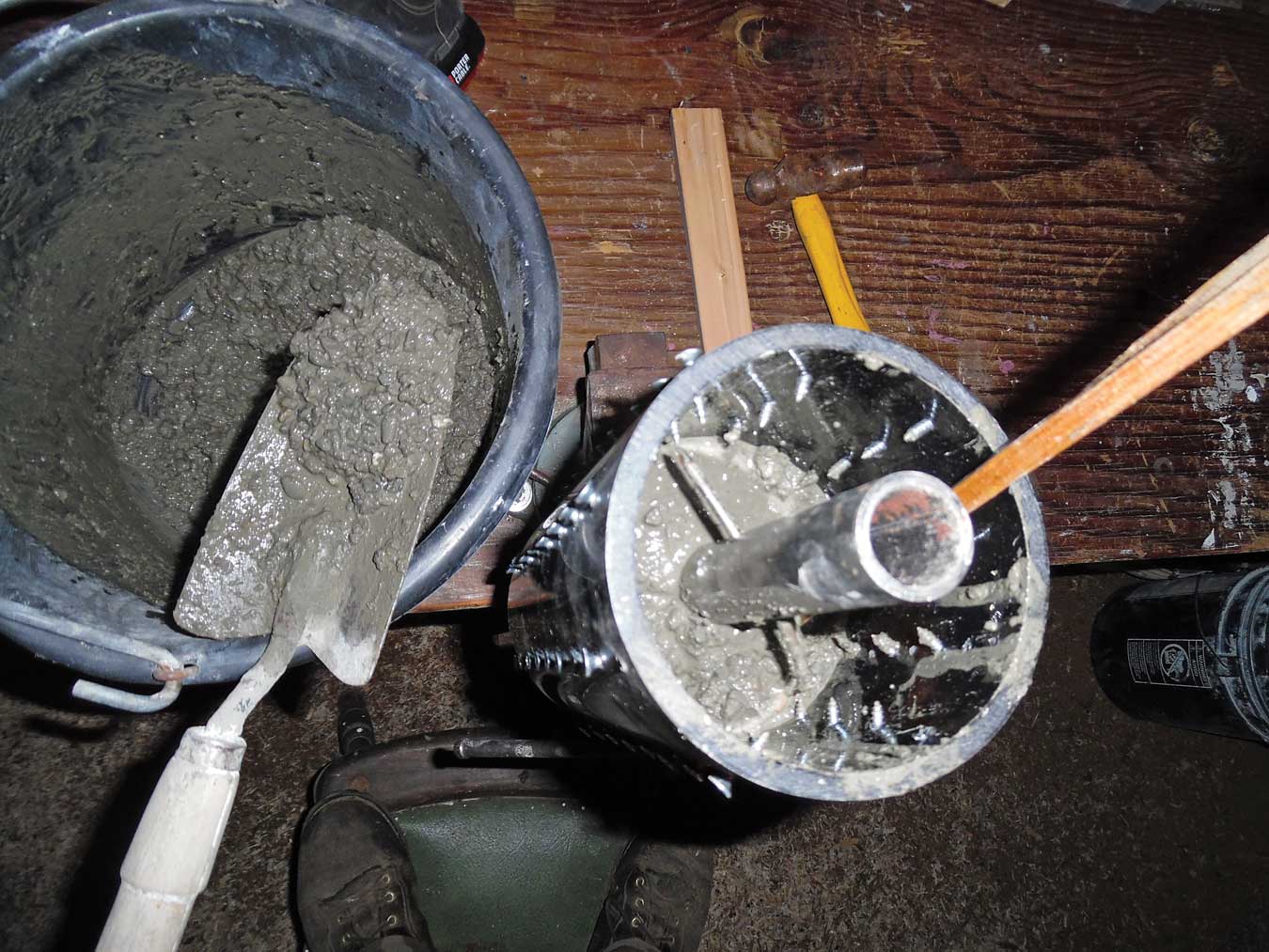
The hopper built around the drum is of ¾” plywood and is just big enough so the teeth don’t hit the sides. This housing must be sturdily made and well supported because two people will be leaning on it during use. The crank arm is a 12-inch length of 2×4 with a hole drilled through one end to fit the shaft and the other end fitted with a handle carved from a scrap of 2×4. The handle rotates freely (mostly) on a 6-inch-long ¼-inch carriage bolt, and the crank arm is bolted through the shaft.
Apples will not gravity-feed through this grinder; they must be forced through with a fitted plunger and firm pressure. The plunger is a close-fitting rectangle of ¾-inch plywood with strips of cedar trim on the underside to better fit around the drum. It swivels on a bolt through a 36-inch-long handle which is secured to one side of the hopper with a hinge. I set it so that the handle hits the top of the hopper just before the plunger bottoms out on the rotating drum, so it doesn’t get chewed up by the teeth. This extra long plunger handle is what makes this grinder work so well. I rubbed down the finished grinder and the rotating shaft with vegetable oil for a food-safe finish.
To use, one person cranks the grinder with both hands, and the other leans on the plunger handle. When operated this way, the grinder works very fast, and turns a hopper full of apples to mash in less than a minute.
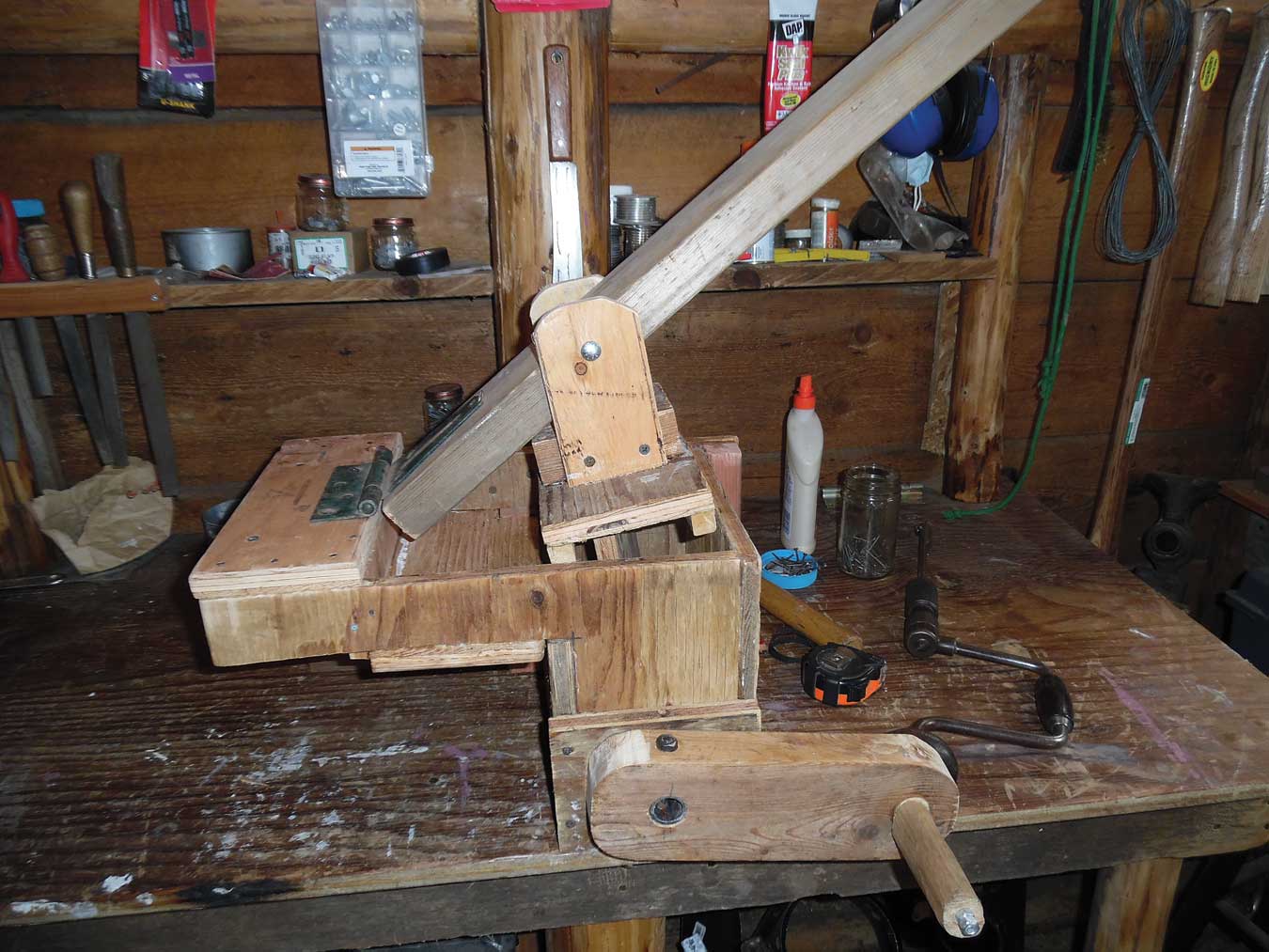
Building the frame
To squeeze the juice out of the mash, I wanted to use a jack to apply pressure. But first I needed a frame to give the jack something to push against. I made my frame of vertical 2x4s with 2×6 cross pieces, plywood sides with shelves below to hold a mash collection pan and juice bucket. I mounted the grinder on one side. The whole thing stands five feet tall so that the press surface and grinder will be at a convenient working height. I’m not going to give a list of materials or detailed dimensions because this contraption was made to fit scraps I had on hand, and I reckon anyone else making one will do the same.
Odds and ends
With the grinder and frame built, there were just a few other things I needed. I modified a cookie sheet with a spout made from a 30-30 cartridge case soldered in place to go under the mash and catch the juice as it is squeezed out. The brass, rimmed cartridge case makes a perfect spout as the rim holds it in place and the brass solders well (use lead-free solder). Next, I needed a rectangular form for the apple mash bundles, just four sides, like a dresser drawer without the bottom. This would be removed before pressing so it didn’t need to be very strong. I used 4-inch-wide strips of ¾-inch plywood, and made the form to fit on the cookie sheet. Then I made several “racks” out of ½-inch plywood, with slots jigsawed into them. These racks go under and over the bundles of mashed apples, and are used to help the juice flow out of the bundles, distribute the force of the press, and help keep the bundles together. For the press cloths to bundle the mash up in we use new cotton kitchen cloths, but they are only just strong enough. Heavy, porous nylon would probably be better. We use a 12-ton hydraulic jack and it’s more powerful than needed. I reckon an old car scissor jack would do. Lastly, I cut a solid rectangle out of ¾-inch plywood to go on top of everything and distribute the force of the jack.
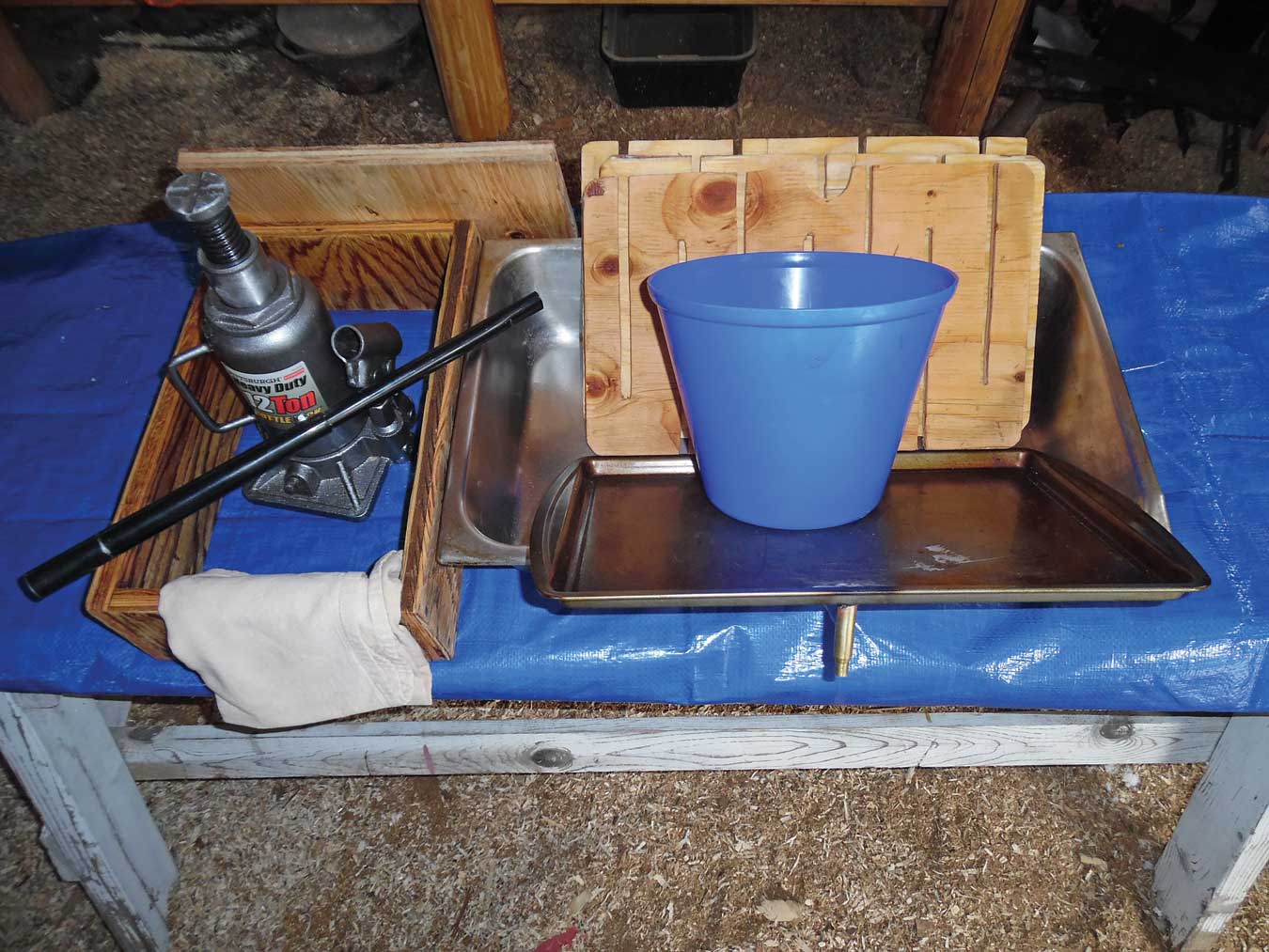
Using the homemade press
To make the cider, we first clean and sort the apples to remove spray residues, dirt, and rotten apples. We cut out bugs and bad bruises. About 20 pounds of apples is a good batch to start with. If using sweet apples, we mix in crabapples to balance the flavor. Once you start making cider and keeping your eyes open for free apples, you’ll be surprised how many there are out there. We have found old abandoned trees along roads, at old homesteads, and even along the side of a local airport.
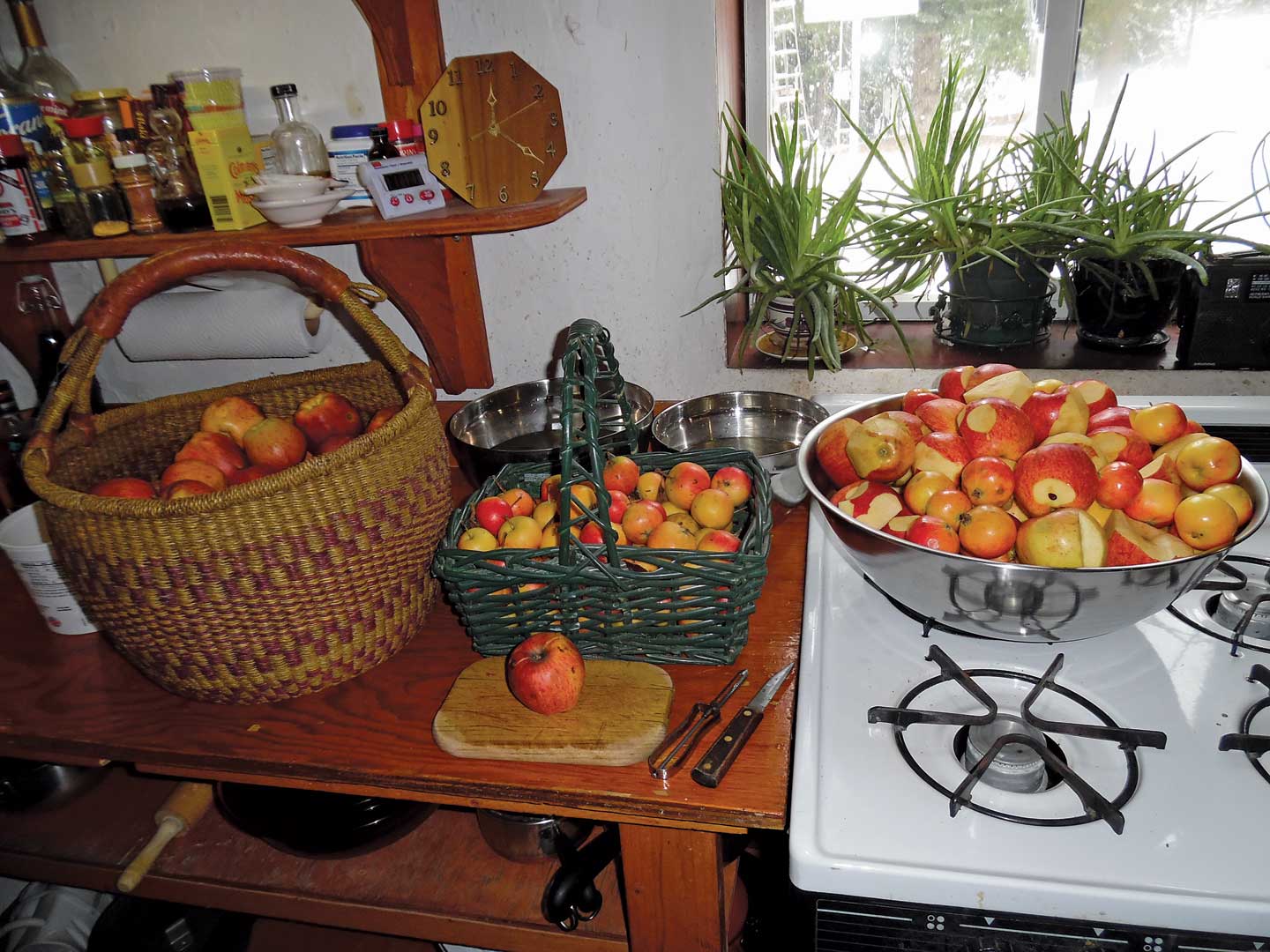
The grinder hopper holds 8-12 apples at a time, and it takes only a minute to grind them up. After three batches through the grinder we have enough for our first press. The modified cookie sheet goes on the press first, then one of the plywood racks with the slots cut in it, then the drawer-without-a-bottom form. We drape a press cloth over the form, then pour or spoon in the apple mash, folding the press cloth around it to make a nice, tight bundle. We remove the form, put another slotted rack on top of the bundle, and put the solid plywood rectangle on top of that.
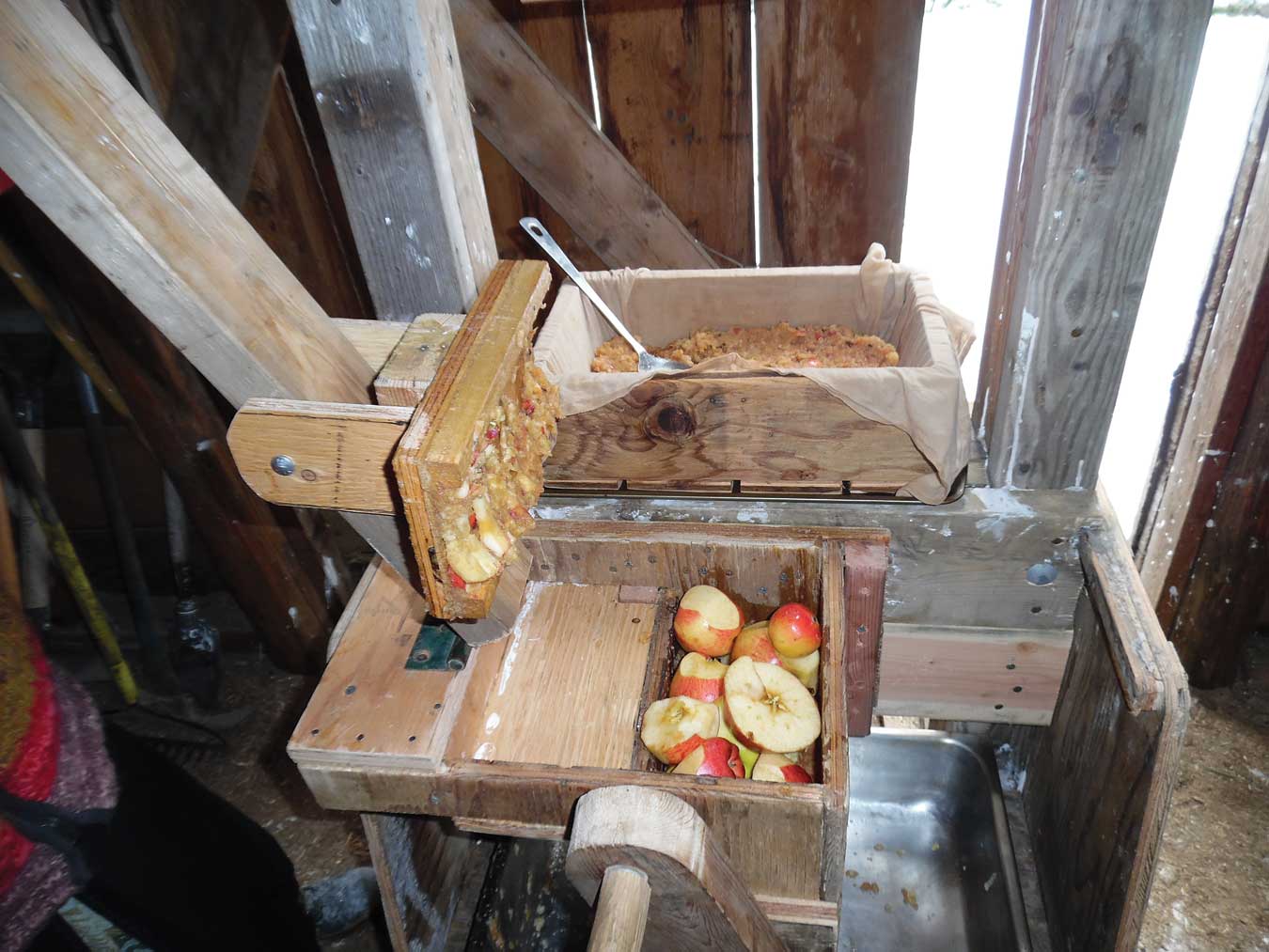
By now the juice is already starting to flow out. We put the jack on top and apply gentle pressure, then dip a cup and sample the crisp, liquid apples. We let the juice flow for several minutes, gradually increasing pressure with the jack. (If you crank the jack too much, you’ll rip the cloths. Try not to drop the jack handle into the cider pot!)
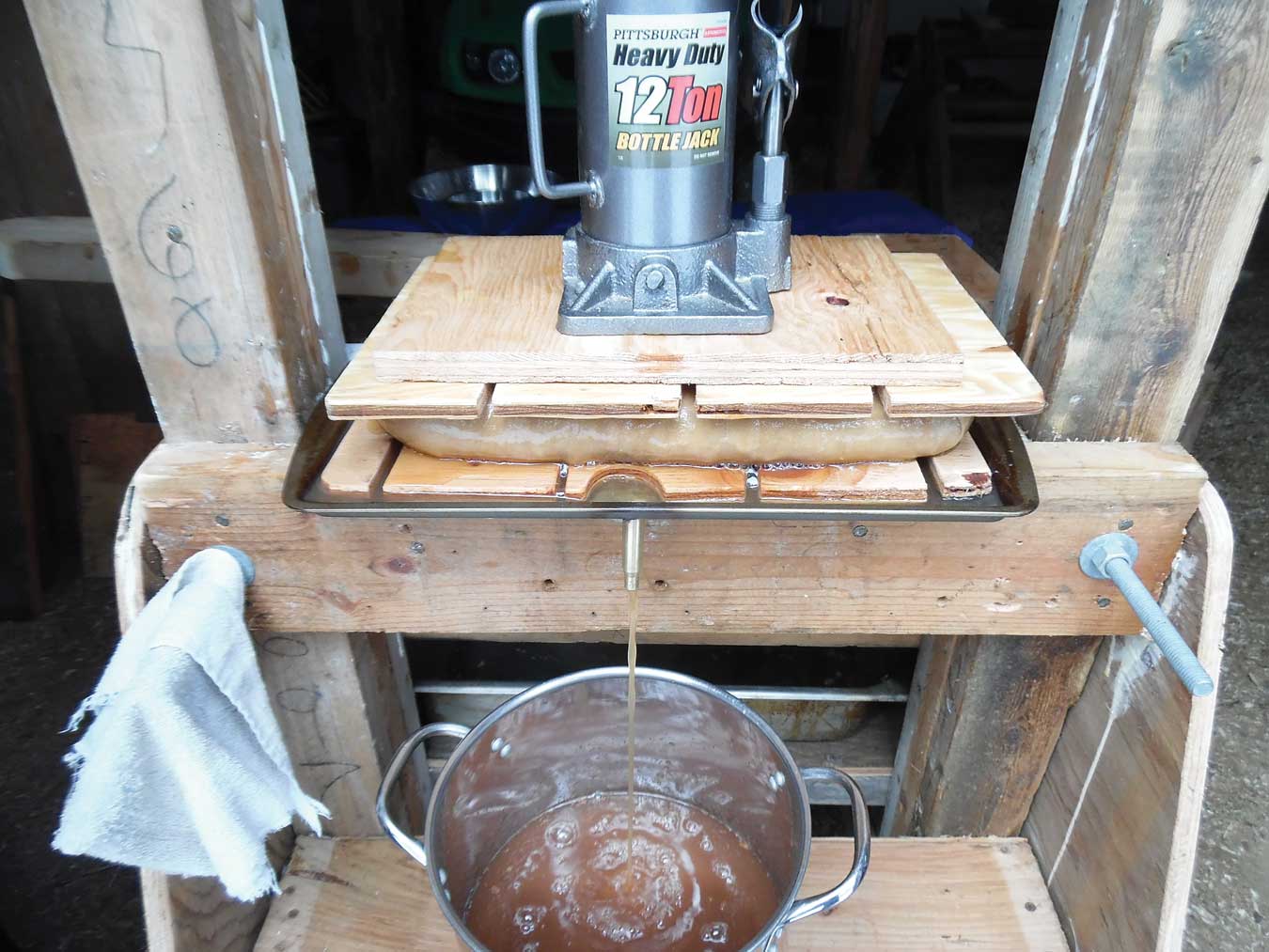
It is possible to stack two or three bundles of mash separated by slotted racks on our press and squeeze them all at once, but in practice we like to press the bundles one at a time. While the first batch is pressing we grind the second batch, and so on. When done, the mash is pressed into compact bricks and is reasonably dry. It can be fed to chickens and hogs.
The extraction ratio of my setup is about 61%. We ground up 22.81 pounds of apples and extracted 13.94 pounds of cider (1.59 gallons). The leftover mash weighed 7.93 pounds which leaves .94 pounds unaccounted for. The wasted material was absorbed by the cotton press cloths, the scraps clinging to the grinder, and so forth. With hydraulic presses, enzymes to digest the apple cores and convert them to sugars, and heat pasteurization, commercial producers approach 100% efficiency, but the end result isn’t the same at all.
Making hard apple cider
When I announced to my family that I was making cider, the very first comment from several of the men was, “You gonna ferment it?” To make hard cider, simply try not to drink up all the fresh cider, and it will start fermenting all by itself. It takes about a month for a batch to get pleasantly fizzy with a slight but noticeable alcohol content. Depending upon the sugar content of the apples used, the brew will eventually reach two to four percent alcohol. You’ll need to put it in a container with some sort of airlock to ferment. I use a big boil-sterilized pot with a well-fitting lid with a bit of weight on top to ferment homemade wines and cider. As the gas pressure builds up inside, the lid will be lifted and “burp” the gas out, then the lid will settle back into place (see “Making simplified country wine” in Backwoods Home Magazine Issue #160, July/August 2016).
Homemade hard cider is astonishingly good; it’s very different from commercial bottled hard ciders. I consider it a healthy probiotic drink full of live natural yeasts and bacteria.
Hard cider used to be our national drink. In Colonial times, hard cider was preferred because it was so easy to make and people couldn’t afford to spare the grain for beer making. Later on, beer gained in popularity with the influx of German settlers and increased grain production. Prohibition was the end of large-scale commercial hard cider production in America, as the government burned whole orchards of tart apples used for hard cider making, and surviving orchards switched to sweet apples for eating. After Prohibition was repealed, the beer makers could easily buy grain, but the cider makers were out of luck.
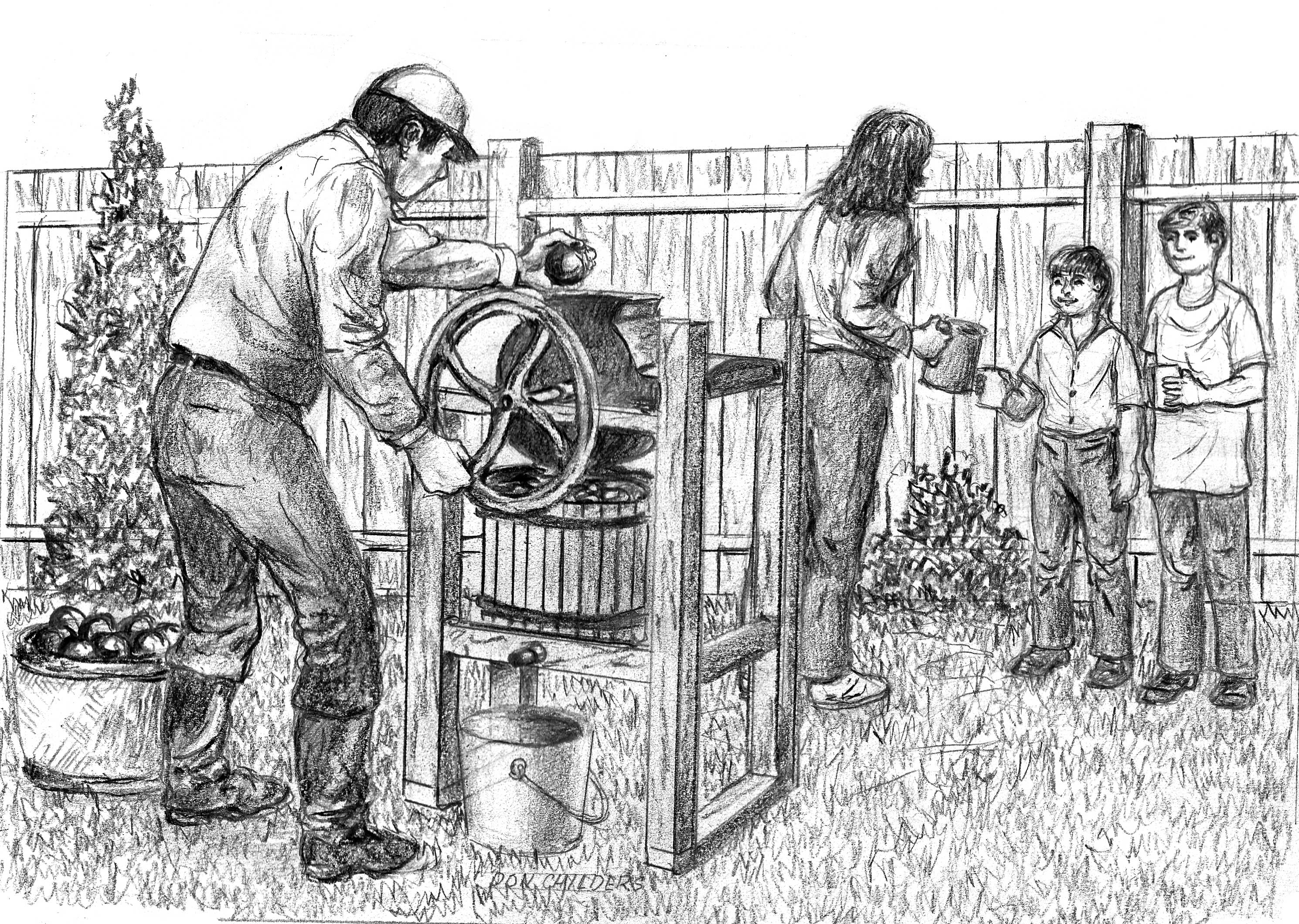
Canning apple cider
Apple cider can be easily preserved by water bath canning. Heat the cider just to a boil, pour into hot, sterile jars leaving ¼ inch headspace, then cap and process for 10 minutes in a boiling-water canner. After some months in storage, a thick layer of sediment settles to the bottom of the jar, leaving a layer of clear apple juice on top, so shake well before opening. The canned cider isn’t nearly as good as fresh — it tastes flat and sort of like the commercial stuff — but it’s still good served cold on a hot summer day. We always can a few gallons to put away.
Apple cider making is an easy, fun activity that the whole family can do together, and it’s carrying on a centuries-old American tradition.


